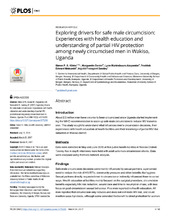| dc.contributor.author | Kibira, Simon Peter | en_US |
| dc.contributor.author | Daniel, Marguerite | en_US |
| dc.contributor.author | Atuyambe, Lynn Muhimbuura | en_US |
| dc.contributor.author | Makumbi, Fredrick Edward | en_US |
| dc.contributor.author | Sandøy, Ingvild Fossgard | en_US |
| dc.date.accessioned | 2018-01-03T08:09:54Z | |
| dc.date.available | 2018-01-03T08:09:54Z | |
| dc.date.issued | 2017-03-31 | |
| dc.identifier.issn | 1932-6203 | |
| dc.identifier.uri | https://hdl.handle.net/1956/17105 | |
| dc.description.abstract | Introduction: About 2.5 million men have voluntarily been circumcised since Uganda started implementing the WHO recommendation to scale up safe male circumcision to reduce HIV transmission. This study sought to understand what influences men's circumcision decisions, their experiences with health education at health facilities and their knowledge of partial HIV risk reduction in Wakiso district. Methods: Data were collected in May and June 2015 at five public health facilities in Wakiso District. Twenty-five in-depth interviews were held with adult safe male circumcision clients. Data were analysed using thematic network analysis. Findings: Safe male circumcision decisions were mainly influenced by sexual partners, a perceived need to reduce the risk of HIV/STIs, community pressure and other benefits like hygiene. Sexual partners directly requested men to circumcise or indirectly influenced them in varied ways. Health education at facilities mainly focused on the surgical procedure, circumcision benefits especially HIV risk reduction, wound care and time to resumption of sex, with less focus on post-circumcision sexual behaviour. Five men reported no health education. All men reported that circumcision only reduces and does not eliminate HIV risk, and could mention ways it protects, although some extended the benefit to direct protection for women and prevention of other STIs. Five men thought social marketing messages were ‘misleading’ and feared risk compensation within the community. Conclusions: Participants reported positive community perception about safe male circumcision campaigns, influencing men to seek services and enabling female partners to impact this decision-making process. However, there seemed to be gaps in safe male circumcision health education, although all participants correctly understood that circumcision offers only partial protection from HIV. Standard health education procedures, if followed at health facilities offering safe male circumcision, would ensure all clients are well informed, especially about post-circumcision sexual behaviour that is key to prevention of risk compensation. | en_US |
| dc.language.iso | eng | eng |
| dc.publisher | PLOS | eng |
| dc.relation.ispartof | <a href="http://hdl.handle.net/1956/17107" target="_blank">Male circumcision, sexual risk behaviour and HIV infection in Uganda. A mixed methods study among men age 15-59 years</a> | |
| dc.rights | Attribution CC BY | eng |
| dc.rights.uri | http://creativecommons.org/licenses/by/4.0 | eng |
| dc.title | Exploring drivers for safe male circumcision: Experiences with health education and understanding of partial HIV protection among newly circumcised men in Wakiso, Uganda | en_US |
| dc.type | Peer reviewed | |
| dc.type | Journal article | |
| dc.description.version | publishedVersion | en_US |
| dc.rights.holder | Copyright 2017 The Author(s) | |
| dc.source.articlenumber | e0175228 | |
| dc.identifier.doi | https://doi.org/10.1371/journal.pone.0175228 | |
| dc.identifier.cristin | 1464976 | |
| dc.source.journal | PLoS ONE | |
| dc.source.40 | 12 | |
| dc.source.14 | 3 | |

